I don't think this is an officially sponsored Departmental artwork in the stairwell of this housing complex.
 Someone needs to have the expression "Don't poop in your nest" explained to them.
Someone needs to have the expression "Don't poop in your nest" explained to them.
 Somewhere in each Police station, there is probably someone running reports on a regular basis on the crime statistics for their area, and these statistics will be pored over by the management team for that area. If they see a flare up in reports of a particular crime (like bag snatching in a shopping mall for instance), they might setup a temporary task force to tackle it. Their decisions will be driven by the numbers. The crimes with the worst numbers or worst trends get the resources - bad numbers are squeaky wheels, Police numbers are the oil.
Somewhere in each Police station, there is probably someone running reports on a regular basis on the crime statistics for their area, and these statistics will be pored over by the management team for that area. If they see a flare up in reports of a particular crime (like bag snatching in a shopping mall for instance), they might setup a temporary task force to tackle it. Their decisions will be driven by the numbers. The crimes with the worst numbers or worst trends get the resources - bad numbers are squeaky wheels, Police numbers are the oil. Prams and pregnant women would be utterly unable to negotiate this path - this photo shows the far end, where the barriers were wide enough to man-handle a bike through - just.
Prams and pregnant women would be utterly unable to negotiate this path - this photo shows the far end, where the barriers were wide enough to man-handle a bike through - just.

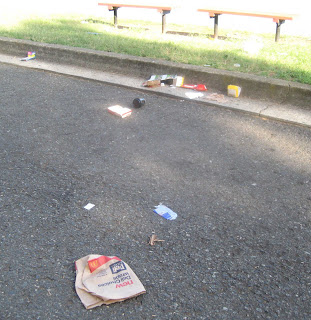
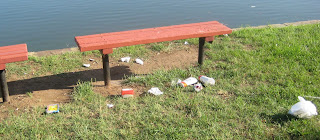
Almost three acres of Sydney’s graffiti has been cleaned up, in a ground breaking project partly funded by the BoysTown Charitable Lottery.In the past 12 months, 10 young indigenous people from social housing in Blacktown and surrounding areas, have been employed and trained to remove graffiti.“Focusing on the Bidwill/Mt Druitt area of western Sydney, the team has since removed over 11,000 square metres of graffiti and repaired roughly 300.

 I've fired off an email to our local MP, Angela D'Amore, attaching these photos and asking her to contact the Minister for Transport in order to get this cleaned up. People at the top should be notified about stupidity at the bottom. The utter lack of common sense that this demonstrates is unbelievable. It can only be a result of brain death.
I've fired off an email to our local MP, Angela D'Amore, attaching these photos and asking her to contact the Minister for Transport in order to get this cleaned up. People at the top should be notified about stupidity at the bottom. The utter lack of common sense that this demonstrates is unbelievable. It can only be a result of brain death. It only took six months, and numerous requests and followups - but in the end, we got a result. Some organisations are more painful to deal with that others, but most come around in the end. All you need is a truckload of tenacity and the ability to grit your teeth in the face of an obstinate unwillingness by some people to do anything about their image and their work environment.
It only took six months, and numerous requests and followups - but in the end, we got a result. Some organisations are more painful to deal with that others, but most come around in the end. All you need is a truckload of tenacity and the ability to grit your teeth in the face of an obstinate unwillingness by some people to do anything about their image and their work environment.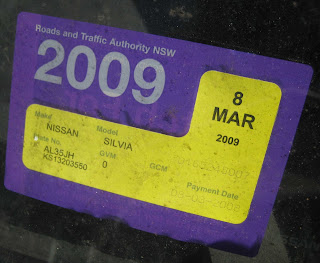
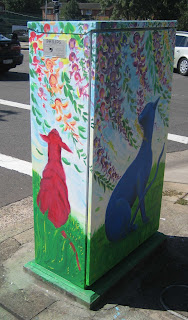

 Almost every light pole along this stretch of road is also tagged, and the lights are generally the responsibility of Energy Australia. Although the RTA and Energy Australia both sit on a government Graffiti Task Force, I guess it was too much to ask for them to coordinate their approach to this location, and to have all the RTA and Energy Australia assets cleaned in the one go. We can only hope that such a thing will come to pass in our lifetime.
Almost every light pole along this stretch of road is also tagged, and the lights are generally the responsibility of Energy Australia. Although the RTA and Energy Australia both sit on a government Graffiti Task Force, I guess it was too much to ask for them to coordinate their approach to this location, and to have all the RTA and Energy Australia assets cleaned in the one go. We can only hope that such a thing will come to pass in our lifetime.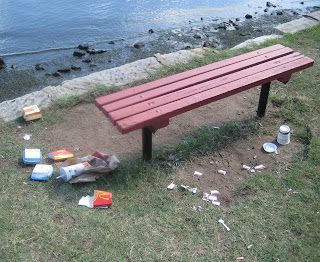
 They can be bothered to make the 1.3km trek from McDonalds to this park (as measured on Google Maps), but can't be bothered to make the 6m journey from this bench to the rubbish bin.
They can be bothered to make the 1.3km trek from McDonalds to this park (as measured on Google Maps), but can't be bothered to make the 6m journey from this bench to the rubbish bin.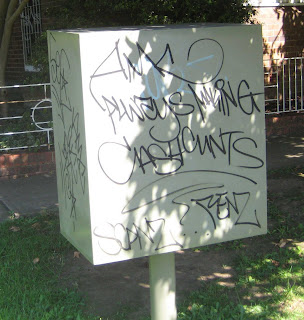

Your request relating to Street Posting Boxes, has been received and a customer service representative will endeavour to respond to you within 2 working days.This is an automated response.Your Enquiry – please clean the graffit from the green post box on the corner of nullawarra ave and wilga st in concord. it is offensive - one tag says "always bring cash c*&nts"..
 Good on them. I rang Leichhardt today and left a message for Allan Willding to let him know that he is a legend.
Good on them. I rang Leichhardt today and left a message for Allan Willding to let him know that he is a legend. The police van was there for some minutes - for all I know they waited there the entire time the fish was frying. They didn't appear to be responding to a crime - they were responding to hunger pangs.
The police van was there for some minutes - for all I know they waited there the entire time the fish was frying. They didn't appear to be responding to a crime - they were responding to hunger pangs..jpg)
27 February 2009
Councillor Jamie ParkerMayorLeichhardt Municipal CouncilPO Box 45Leichhardt NSW 2040Dear Mr ParkerRemoval of graffiti from railway structures in LeichhardtI have had a series of correspondence with RailCorp since May 2008 regarding the removal of graffiti from a rail bridge at Charles St, Leichhardt (near the corner of Darley St).The last response from RailCorp in November suggested that I contact your Council in order to have it removed. Personally, I doubt that the removal of graffiti from railway bridges is a Council responsibility, but I did phone Leichhardt Council in November to report it.I would appreciate it if you would approach RailCorp and ask them to clean up the bridge in question, and assist them with any road closures that may be required to repaint or clean the bridge.Yours sincerely
 They don't sit around though and wait for someone else to report it and remove it. They get right onto it, reporting it to Waverly Council straight away and reporting dumpers if they catch them in the act.
They don't sit around though and wait for someone else to report it and remove it. They get right onto it, reporting it to Waverly Council straight away and reporting dumpers if they catch them in the act.17 March 2009Mr David YoungGeneral Manager, Operations & SustainabilitySydney Olympic Park Authority7 Figtree DriveSydney Olympic Park NSW 2127Dear Mr YoungDamage to park signage in Bicentennial ParkI refer to signage near the Victoria Road entrance to Bicentennial Park.

A number of structures around the Victoria Road entrance were defaced with graffiti in late 2008. Whilst the graffiti has long been removed, several signs that were damaged beyond recognition have not been replaced. The photo above shows one of them.May I suggest that if the removal of graffiti also removes much of the information on the sign, then the sign should be replaced. It’s not much use to visitors in its current condition. A nearby sign was damaged so severely, it was removed – and it hasn’t been replaced yet either. It might also be an idea to coat the signs so that graffiti can be removed without destroying the sign.Yours sincerely

 I'm tempted to FOI the timetable for this section of line for the last few months, including the SWT (Special Working Timetable), which lists any special trains (ie, trains not in the regular timetable) that have gone past here. The goods yard at the end of the line is showing no activity and plenty of tall weeds, so it would appear likely that the line is unused. If the timetable shows that no trains are using this track, or they are only using it once every week or so, then someone at RailCorp has been fibbing.
I'm tempted to FOI the timetable for this section of line for the last few months, including the SWT (Special Working Timetable), which lists any special trains (ie, trains not in the regular timetable) that have gone past here. The goods yard at the end of the line is showing no activity and plenty of tall weeds, so it would appear likely that the line is unused. If the timetable shows that no trains are using this track, or they are only using it once every week or so, then someone at RailCorp has been fibbing.6 March 2009The Hon. Ian MacdonaldMinister for Primary Industries, Minister for Energy, Minister for Mineral Resources, Minister for State DevelopmentLevel 33Governor Macquarie Tower1 Farrer PlaceSYDNEY NSW 2000Dear Mr MacdonaldEnergy Australia – graffiti reporting policyAs you may be aware the Attorney General’s Department runs an Anti-graffiti action team, of which Energy Australia is a member.It has come to my attention that not all government authorities are reporting graffiti to the Police, even though this is strongly recommended by the Attorney General’s Department, and is plain common sense.I have reported a number of instances of graffiti to Energy Australia over the past 9 months. I want to be assured that as well as removing the graffiti, Energy Australia are reporting each incident to the Police for recording in the COPS database.I have attached a list of Energy Australia case numbers, each referring to a report of graffiti that I have made to Energy Australia via telephone. In all cases, the graffiti has been removed. However, what I want to see is the COPS Event Number for each case, and the date each report to the Police was made.Please arrange for Energy Australia to provide this information to me.If Energy Australia has not been reporting graffiti to the Police, then I would like you to explain how a failure to report fits in with the government’s anti-graffiti stance.Yours sincerelyKiosk Energy Australia reference numberk2051 REF 5000640833219 REF 5000640842829 REF 5000640853599 REF 500064086K1573 REF 5000640874854 REF 500064088500628855006288650062887500628885006288950062890500628925006289350062894500628965006289750005933950005875450005875550005855950005836950005839650003897500038985000583485000583735000583470500058371500058372Substation 3219 Ref 500058614Substation k2051 Ref 500058615Substation cp228 Ref 500058616Substation at manning & springside Ref 500058617Substation 4082 Ref 500058618Substation 2178 Ref 500058619Substation at Barnstaple & Trevanion Ref 500058630













